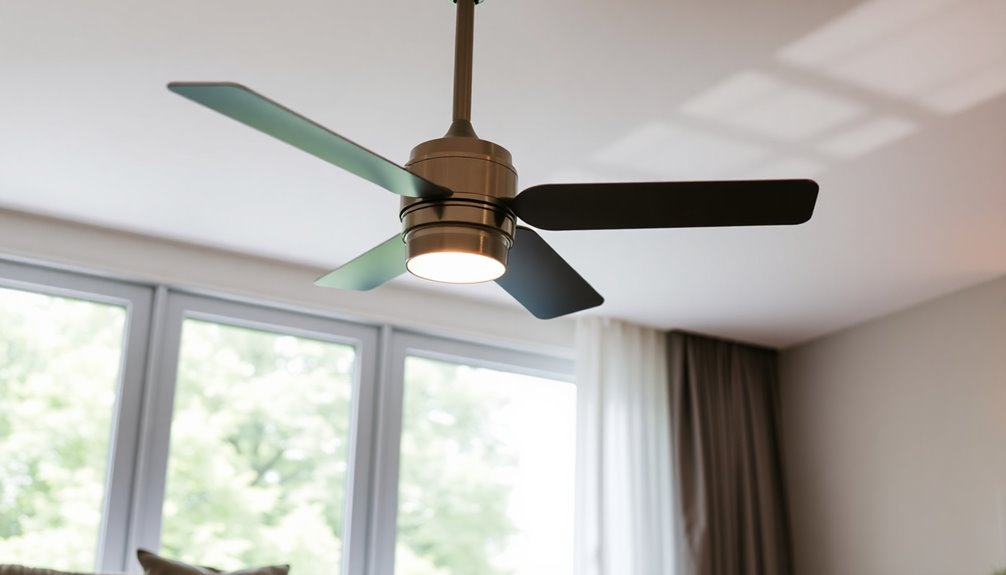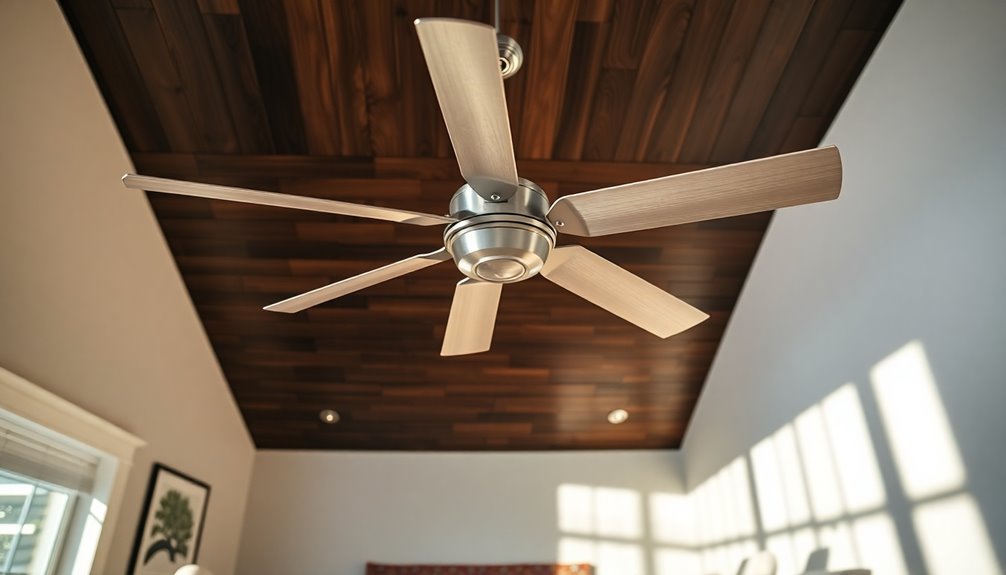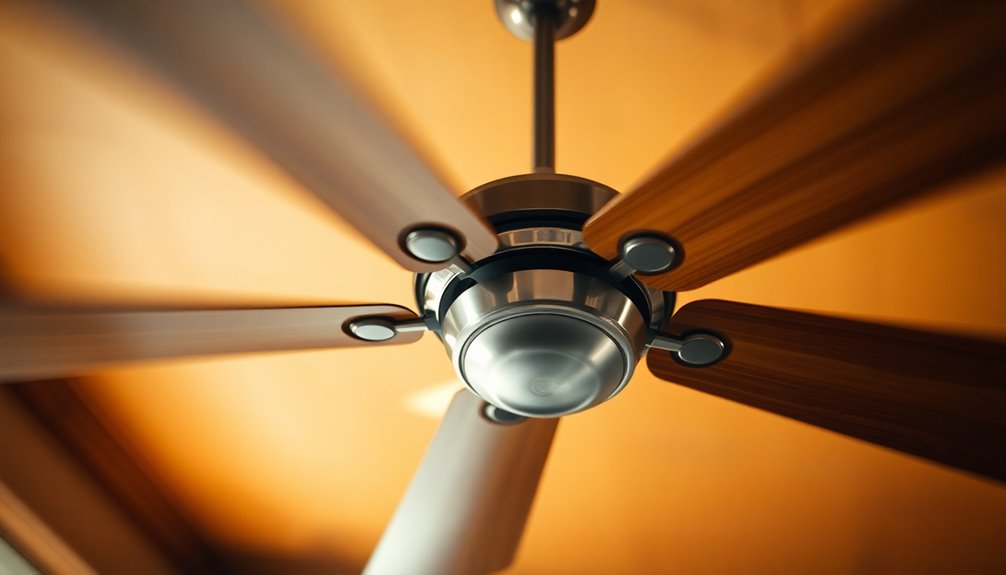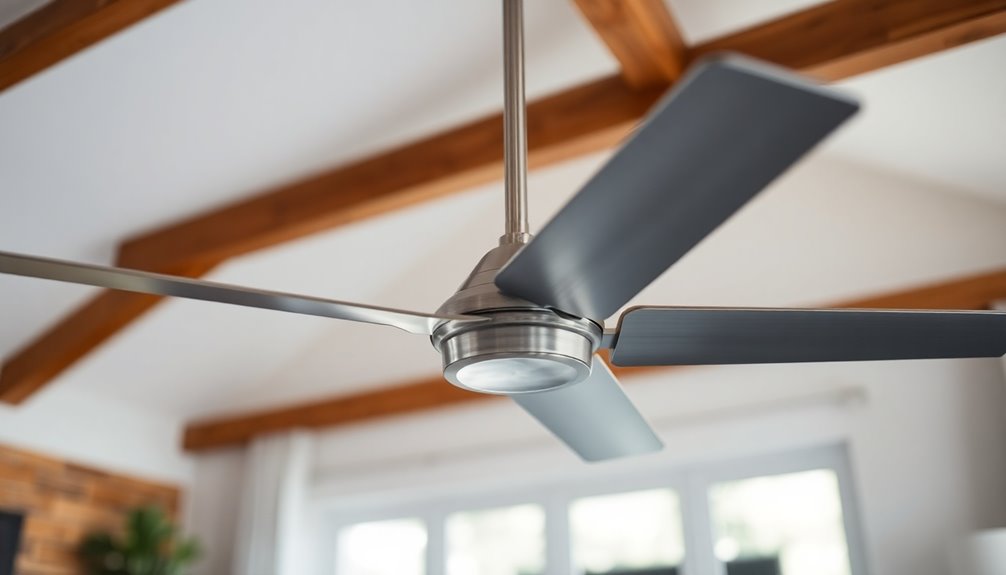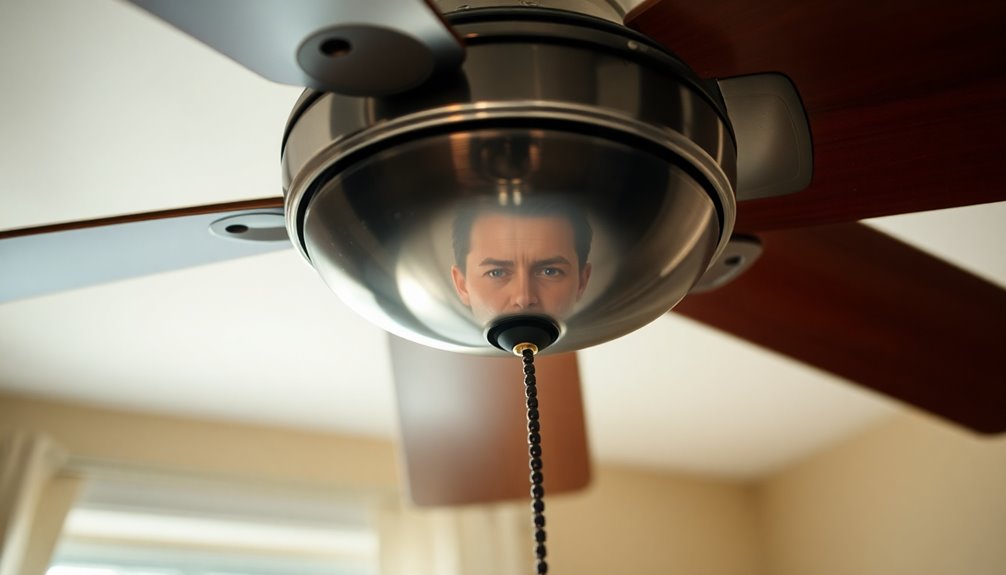A good CFM for a ceiling fan usually falls between 2,000 and 5,000, depending on the size of your room. For small spaces (up to 12×12 feet), you'd want around 1,000 CFM. Medium rooms require 2,000 to 3,000 CFM, while larger areas benefit from 3,000 to 4,000 CFM. For very large spaces, aim for 4,000 to 8,000 CFM. Factors like blade size and pitch also affect airflow, so consider those when selecting a fan. If you're curious about maximizing efficiency and performance, there's even more to discover about choosing the right fan for your needs.
Key Takeaways
- A good CFM for ceiling fans typically ranges from 2,000 to 5,000 for effective airflow in residential spaces.
- Small rooms (up to 12×12 feet) generally require around 1,000 CFM for optimal comfort.
- Medium rooms (up to 15×15 feet) usually need CFM ratings between 2,000 and 3,000.
- Larger rooms (20×20 feet) benefit from fans that provide 3,000 to 4,000 CFM.
- Very large spaces (24×24 feet or more) may require fans exceeding 4,000 CFM for efficient airflow.
Understanding CFM

When it comes to ceiling fans, understanding CFM—Cubic Feet per Minute—is vital for guaranteeing you get the right amount of airflow for your space. CFM measures the volume of air moved by a fan in one minute, and it's a significant indicator of a fan's cooling efficiency.
For average residential applications, you'll typically want a CFM rating between 2,000 and 5,000, but this depends on your room size and specific cooling needs.
When selecting a ceiling fan, take note that the CFM rating can vary based on factors like blade size, pitch, and motor speed. Generally, larger blades with steeper pitches yield higher CFM values, which means better airflow.
Fans are designed to operate most effectively at high speeds, where these ratings are usually calculated, so it's important to check these specifications.
To achieve ideal comfort, you should match the CFM of the ceiling fan to your room size. For example, you might need around 1,000 CFM for a small room, while larger open spaces could require up to 10,000 CFM to guarantee adequate cooling efficiency.
Importance of Airflow

Airflow is essential for creating a comfortable living environment, as it directly impacts how effectively a ceiling fan cools and circulates air in your space. The airflow efficiency of a ceiling fan is primarily measured by its CFM rating, which indicates how much air the fan can move in a minute. A higher CFM means the fan can move more air, providing better cooling, especially in larger rooms or outdoor areas.
For instance, small rooms typically need around 1,000 CFM, while larger spaces might require 4,000 CFM or more to achieve adequate airflow. This difference highlights the significance of selecting a fan that matches the size of your room.
Additionally, the perceived cooling effect isn't solely about CFM; it also involves air velocity and the fan's ability to create a wind chill effect. Proper airflow direction and fan speed are vital in maximizing comfort and energy efficiency throughout different seasons.
Factors Affecting CFM

When it comes to CFM, blade pitch and motor power play pivotal roles.
A steeper blade pitch can boost airflow efficiency, while a more powerful motor allows for higher RPMs, enhancing air movement.
Understanding these factors will help you choose the right ceiling fan for ideal cooling.
Blade Pitch Impact
Blade pitch plays an important role in determining how effectively your ceiling fan moves air. The angle of the fan blades can greatly influence CFM, or cubic feet per minute, which is a measure of airflow. A steeper pitch generally leads to a higher CFM rating, enhancing air movement and cooling efficiency.
To help you understand the impact of blade pitch on airflow, here's a quick overview:
| Blade Pitch (Degrees) | Expected CFM Increase | Ideal Room Size |
|---|---|---|
| 10 | 10% | Small rooms |
| 12-15 | best | Medium rooms |
| 15+ | 30% or more | Larger spaces |
Fans with a blade pitch of 12 to 15 degrees are typically best for achieving higher CFM and effective air circulation. Each additional degree of pitch can boost CFM output by about 10%, especially when combined with proper blade length and motor speed. Overall, the right blade pitch, along with the size and speed of your ceiling fan, is vital for maximizing airflow in your space.
Motor Power Influence
The effectiveness of a ceiling fan isn't just about blade pitch; motor power also plays a significant role in determining CFM. When you're choosing a fan, keep in mind that higher horsepower typically means better airflow. A powerful motor can maintain higher RPMs, which allows the fan to move more air in less time, thereby enhancing airflow efficiency.
Generally, fans with motors rated at 1/2 HP or greater produce higher CFM ratings, making them ideal for larger spaces. However, it's vital to also consider energy-efficient motors. These motors can deliver impressive CFM while consuming less energy, making them a sustainable option for your home.
When selecting a ceiling fan, don't focus solely on blade design or size; the motor's power is important too. By balancing motor power with these other factors, you'll achieve the desired cooling effect and best airflow.
Ultimately, understanding the interplay between motor power and CFM can help you make a more informed decision, ensuring you get a fan that meets your needs effectively.
CFM Ratings Explained

Understanding CFM ratings is essential for choosing the right ceiling fan for your space.
These ratings reflect how much air a fan can move, impacting your comfort and energy efficiency.
You'll want to take into account factors like blade design and fan size, as they all play a role in determining the CFM you can expect from your fan.
Understanding CFM Importance
Ceiling fan efficiency often hinges on CFM, or Cubic Feet per Minute, which measures how much air the fan can move. Understanding CFM is essential because it directly influences the cooling effectiveness of your fan.
For an average-sized room, a CFM rating between 2,000 and 5,000 is ideal, with the general guideline suggesting around 4,000 to 5,000 CFM for rooms with 8-foot ceilings.
When selecting a ceiling fan, consider the following:
- Blade Size: Larger blades typically move more air, increasing CFM.
- Motor Speed: High-speed settings can greatly boost airflow, enhancing cooling benefits.
- Room Size: The larger the room, the higher the CFM needed to effectively move air.
Factors Affecting CFM Ratings
Airflow efficiency in ceiling fans is influenced by several critical factors that determine their CFM ratings. Understanding these aspects can help you choose the right fan for your space.
| Factor | Impact on CFM | Notes |
|---|---|---|
| Rotations Per Minute (RPM) | Higher RPM increases airflow, leading to higher CFM values. | Ideal RPM varies by fan type. |
| Blade Size | Larger blades can move more air, improving airflow efficiency. | Consider room size when selecting. |
| Blade Pitch | A steeper pitch enhances airflow by increasing air moved per rotation. | Perfect pitch varies by design. |
| Fan Design | Motor power and blade shape affect CFM ratings; refined designs yield better airflow. | Look for energy-efficient models. |
| Static Pressure | Ductwork or room configurations can reduce effective CFM. | Confirm proper room dimensions. |
CFM Requirements by Room Size

When choosing a ceiling fan, it's vital to evaluate the specific CFM requirements based on your room size. The right CFM guarantees effective air circulation and ideal airflow, making your space comfortable.
- For small rooms (up to 12×12 feet), aim for around 1,000 CFM.
- Medium-sized rooms (up to 15×15 feet) typically require fans within a CFM range of 2,000 to 3,000.
- Large rooms (approximately 20×20 feet) benefit from fans that deliver between 3,000 to 4,000 CFM for proper cooling.
If you're dealing with very large spaces (about 24×24 feet or more), look for fans with a CFM rating of 4,000 to 8,000 to guarantee adequate airflow.
Outdoor areas usually require even more power, with fans exceeding 10,000 CFM to combat the challenges of open spaces. Additionally, the right CFM rating is essential for ensuring optimal comfort in any environment.
Comparing Fan Types and CFM

When you're evaluating ceiling fan options, it's essential to take into account their CFM ratings alongside other types like exhaust and ventilation fans.
Ceiling fans usually range from 1,000 to 10,000 CFM, while exhaust fans typically sit between 50 to 150 CFM for smaller spaces.
Understanding these differences will help you choose the right fan for your specific needs, whether for comfort or efficient air removal.
Ceiling Fan CFM Ratings
How do different ceiling fan types impact their CFM ratings? Ceiling fan CFM varies considerably based on the fan's size and design. For instance, larger ceiling fans typically have a higher CFM, making them ideal for spaces like large living rooms or outdoor patios.
Fans with a 60-inch blade span can achieve CFM ratings closer to 10,000, ensuring effective cooling in expansive areas.
Consider these factors when selecting a ceiling fan:
- Blade Pitch: A steeper blade pitch enhances airflow, resulting in higher CFM and better cooling performance.
- Room Size Requirements: For effective cooling, aim for about 1,000 CFM in small rooms, 2,000-3,000 CFM for medium spaces, and 4,000-6,000 CFM for larger areas.
- Energy Efficiency: Look for fans that provide a minimum of 1,250 CFM at low speed and can reach up to 7,500 CFM at high speed, balancing cooling power and energy conservation.
Exhaust Fan Requirements
Ceiling fans and exhaust fans serve different purposes, each with specific requirements for air movement. When it comes to exhaust fans, you'll typically find that they require lower CFM ratings than ceiling fans.
For instance, in bathrooms, CFM ratings usually range from 50 to 150 to guarantee proper moisture removal. If you're tackling kitchen ventilation, however, expect to need around 300 to 600 CFM to effectively eliminate cooking odors and smoke.
The required CFM for exhaust fans also varies based on room size. A bathroom measuring 50 square feet may only need about 50 CFM, while larger spaces demand higher CFM ratings for adequate air exchange.
In ventilation applications, it's vital to take into account static pressure in ductwork, as this can diminish airflow efficiency if overlooked.
For larger or commercial spaces, higher CFM ratings in exhaust fans become necessary. In such cases, you might need multiple fans working together to achieve effective ventilation.
Understanding these requirements helps you choose the right exhaust fan for your specific needs, guaranteeing ideal air quality and comfort in your space.
Ventilation Fan Efficiency
Ventilation fan efficiency hinges on several key factors that impact their performance and effectiveness. To guarantee you choose the right ventilation fan for your space, consider the following:
- CFM Ratings: Depending on your room size, ventilation fans typically require higher CFM ratings, ranging from 4,000 to 9,000 CFM for ideal airflow.
- Blade Size and Pitch: Larger blades with steeper pitches generally produce higher CFM outputs, enhancing air circulation in your space.
- Motor Power: A powerful motor is essential for maintaining airflow, especially in larger commercial areas where multiple fans may be needed.
When calculating CFM for ventilation fans, it's vital to factor in room dimensions and desired air exchanges. For example, a 25 L x 30 W x 20 H space typically needs at least 2,358 CFM for effective ventilation.
Additionally, don't overlook static pressure in ductwork, as it can considerably affect airflow and CFM ratings. By understanding these elements, you'll make an informed decision on the best ventilation fans to keep your environment comfortable and well-ventilated. Regular maintenance of these fans can contribute to improved energy efficiency and overall performance.
Energy Efficiency Considerations

Energy efficiency is a significant factor when selecting a ceiling fan, as it directly impacts both your comfort and your utility bills. When you choose an energy-efficient ceiling fan, you'll notice a substantial difference in your cooling bills.
Look for models that are Energy Star certified; these fans meet minimum CFM ratings of 1,250 at low speed, 5,000 at medium speed, and 7,500 at high speed, ensuring excellent airflow efficiency.
High airflow efficiency is essential, measured in CFM per watt. Aim for at least 155 CFM/watt at low speed, 100 CFM/watt at medium speed, and 75 CFM/watt at high speed. By selecting a fan that offers high CFM ratings, you not only benefit from better air circulation but also lower energy consumption, which enhances your overall comfort without spiking your energy bills. Additionally, choosing a fan with HEPA filters can further improve indoor air quality by minimizing airborne allergens and pollutants.
On average, ceiling fans use about 60-100 watts, making the choice of energy-efficient models important for sustainable living.
Selecting the Right Fan

Choosing the right fan can greatly enhance your comfort and cooling experience in any space. When selecting a ceiling fan, you'll want to take into account the CFM (cubic feet per minute) rating, which indicates the airflow it can provide.
The ideal CFM depends on the room size:
- For small rooms (up to 12×12 feet), aim for around 1,000 CFM.
- Medium rooms (up to 15×15 feet) should have fans that deliver between 2,000 and 3,000 CFM.
- Large rooms (20×20 feet) benefit from fans providing 3,000 to 4,000 CFM, while very large spaces (24×24 feet) require 4,000 to 8,000 CFM.
Additionally, take into account the blade size and pitch. Larger blades with steeper pitches typically generate higher CFM, improving airflow.
If you're looking to cool outdoor spaces, fans should exceed 10,000 CFM to guarantee adequate airflow in open conditions.
Benefits of High CFM Fans

When it comes to cooling large spaces, high CFM fans stand out as an excellent choice. Designed to be effective for rooms over 300 square feet, these fans typically offer a CFM range of 4,000 to 6,000. You'll notice the difference in performance, as they circulate air efficiently, ensuring you stay comfortable even on the hottest days.
One of the biggest benefits of high CFM fans is their low operating cost. You'll find that they often cost only a few cents per day to run, leading to significant energy savings over time. By pairing these fans with your air conditioning system, you can even raise your thermostat settings a few degrees without sacrificing comfort, which can further lower your energy bills.
Additionally, larger high CFM fans usually operate quietly and with less vibration, creating a more pleasant environment. Their durability and stability mean they're built to last, minimizing the need for replacements and maintenance.
Tips for Optimal Fan Performance

To get the most out of your high CFM ceiling fan, it's important to implement some key strategies for ideal performance.
First, verify that the fan's CFM rating matches the size of the room. For small rooms, aim for 2,000 to 3,000 CFM, while larger spaces over 450 sq ft should utilize fans with 5,000 to 9,000 CFM.
Here are some tips to enhance air circulation and efficiency:
- Maintain proper ceiling height: Position your fan 7 to 9 feet above the floor for best air circulation.
- Clean your fan regularly: Dust and debris can impede airflow, reducing the CFM output, so keep those blades and the motor clean.
- Adjust the blade pitch: A steeper angle can greatly improve airflow, enhancing the CFM and cooling performance.
Frequently Asked Questions
Is 8000 CFM Good?
If you're wondering whether 8000 CFM is good, it definitely is!
This rating suits large areas, providing excellent airflow for spaces over 450 square feet. You'll find it particularly effective in open living rooms, big bedrooms, or outdoor patios where strong air movement is essential.
With an 8000 CFM fan, you can stay comfortable while potentially reducing your reliance on air conditioning.
Just make sure it's designed well for peak performance!
Is 6000 CFM Good for a Fan?
Imagine standing in a breezy meadow, the air invigorating and cool.
A fan with 6000 CFM is definitely good for your space, especially if it's over 450 square feet. This rating guarantees effective air circulation, making your room feel more comfortable during hot days.
Just remember, you'll want to take into account your ceiling height and layout for ideal airflow. With 6000 CFM, you might even rely less on air conditioning!
Is Higher CFM Better for My Fan?
Yes, a higher CFM can be better for your fan, especially if you're looking to cool larger spaces efficiently.
It means your fan can move more air, improving airflow and comfort in your room.
However, it's important to balance this with energy efficiency to avoid high energy bills.
Look for a fan that meets your cooling needs while also being Energy Star-rated to guarantee peak performance without excessive power usage.
Is 4000 CFM Good?
Absolutely, a CFM of 4000 is excellent for your space.
If you've got a medium to large room, this rating provides effective air circulation and helps keep you cool.
You'll notice improved indoor air quality with around 4 to 6 air exchanges per hour.
Plus, a higher CFM like this can cut down on your air conditioning usage, saving you energy and money during those hot months.
It's a smart choice!
Conclusion
When choosing a ceiling fan, remember that a good CFM (cubic feet per minute) rating can dramatically improve your comfort. For instance, a fan with a CFM of 5,000 can circulate air in a 20×20 room, making it feel up to 10 degrees cooler on a hot day. By selecting the right fan, you not only enhance airflow but also boost energy efficiency, ensuring you enjoy a revitalizing breeze while keeping your utility bills in check.
